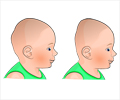Manual Rotation - External Cephalic Version
An External Cephalic Version (ECV) or manually turning the baby from outside the mother's abdomen may be attempted to turn a breech to headfirst.
Women with breech presentation, reassuring fetal heart rate tracings, and no contraindications to vaginal delivery at 36 weeks' gestation and beyond are usually candidates for ECV. ECV is a safe alternative to vaginal breech delivery or cesarean delivery, reducing the cesarean delivery rate for breech by 50%. External cephalic version is nearly always attempted in a hospital with emergency cesarean facilities ready.
- Procedure
Prepare for the possibility of cesarean delivery. The patient should have nothing by mouth for at least 8 hours prior to the procedure. Perform a non stress test (biophysical profile as backup) prior to ECV to confirm fetal well-being. The Fetal Non-Stress test is a simple, non-invasive test performed in pregnancies over 28 weeks gestation. The test involves attaching one belt to the mother's abdomen to measure fetal heart rate and another belt to measure contractions. Following an ECV attempt, whether successful or not, repeat the nonstress test (biophysical profile if needed) prior to discharge. In those with an unsuccessful ECV, the practitioner has the option of sending the patient home or proceeding with a cesarean delivery.
- Success rate
Success rates vary widely but range from 35-86% (average, 58%). Improved success rates occur with multiparity, with earlier gestational age, with frank breech presentation, with a transverse lie, and in African American patients. The performance of an ECV decreases the cesarean delivery rate for breech by approximately 50%.
- Risks of ECV
Uncommon risks of ECV include fractured fetal bones, precipitation of labor or premature rupture of membranes, abruptio placentae, fetomaternal hemorrhage (0-5%), and cord entanglement (<1.5%). A more common risk of ECV is transient slowing of the fetal heart rate (in as many as 40% of cases).
- Contraindications
a. Absolute contraindications for ECV include
- Multiple gestations with a breech-presenting fetus.
- Contraindications to vaginal delivery (eg, herpes simplex virus infection, placenta previa).
- Non reassuring fetal heart tracing is fetal heart tracing suggestive of hypoxia, which may be Fetal. Tachycardia (>160), Fetal bradycardia(<120),Variable decelerations, and early decelerations.
b. Relative contraindications include
- Polyhydramnios or oligohydramnios.
- Fetal growth restriction.
- Uterine malformation.
- Fetal anomaly.

















